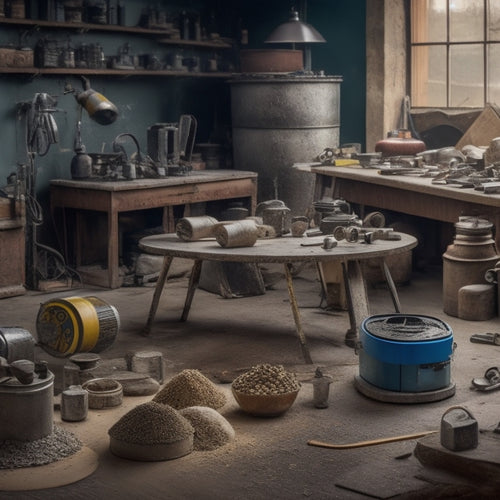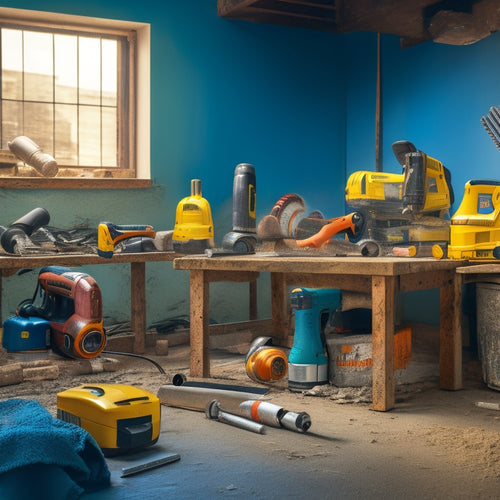
3 Key Quality Control Checks for Concrete Forming Tools
Share
When working with concrete forming tools, you must conduct thorough quality control checks to guarantee structural integrity. First, inspect formwork for damage, wear, or corrosion, addressing any issues promptly to prevent further deterioration. Next, check the alignment and levelness of the formwork, using specialized tools like string lines and laser levels to prevent uneven pours. Finally, verify that ties and bracing systems are securely fastened and positioned, replacing any suspect components to avoid formwork failure. By following these three key quality control checks, you can prevent costly repairs and guarantee a successful concrete project - and that's just the foundation.
Key Takeaways
• Inspect formwork for damage, wear, or corrosion before use, addressing any issues promptly to prevent further deterioration.
• Ensure formwork is properly aligned and leveled to prevent uneven pours, using tools like string lines, laser levels, or optical levels.
• Verify all ties and bracing systems are securely fastened and positioned, replacing any suspect components to avoid formwork failure.
• Check for signs of damage, rust, or corrosion on ties and bracing systems, ensuring they are properly tightened and attached.
• Follow manufacturer's guidelines for repair and maintenance standards to ensure formwork meets structural integrity requirements.
Inspect Formwork for Damage
Inspect the formwork for signs of damage, wear, or corrosion before each use to prevent defects in the concrete pour and guarantee the structural integrity of the finished product. You'll want to examine the formwork materials carefully, paying attention to any cracks, dents, or rust spots that could compromise the structure. If you notice any damage, it's vital to address it promptly to prevent further deterioration.
You may need to employ specialized repair techniques to restore the formwork to its original condition. This might involve replacing damaged sections, applying epoxy coatings, or using other restoration methods. It's critical to follow the manufacturer's guidelines for repair and maintenance to ascertain the formwork meets the required standards.
Check Alignment and Levelness
After verifying the formwork's condition, you'll need to guarantee that it's properly aligned and leveled to prevent uneven concrete pours and potential structural issues.
Alignment is critical, as even minor deviations can lead to significant problems down the line. To ascertain accurate alignment, employ established techniques such as string lines, laser levels, or optical levels. These methods allow you to precisely set the formwork's orientation and verify its position.
Next, you'll need to check the formwork's levelness using specialized leveling tools. These tools, like spirit levels or digital levels, provide precise readings of the formwork's inclination. Make adjustments as necessary to achieve a perfectly level surface.
It's important to remember that even slight deviations from level can cause significant issues, including uneven concrete pours, structural weaknesses, and decreased load-bearing capacity.
Verify Ties and Bracing
You must confirm that all ties and bracing systems are securely fastened and properly positioned to maintain the formwork's structural integrity during the concrete pour. This is essential because any weakness in tie integrity or bracing stability can lead to formwork failure, resulting in costly repairs, delays, and even safety hazards.
As you inspect the ties and bracing, check for any signs of damage, rust, or corrosion that could compromise their strength. Verify that all ties are properly tightened and that the bracing systems are securely attached to the formwork.
Additionally, verify that the bracing is properly angled and positioned to provide maximum support. Remember, it's better to err on the side of caution and replace any suspect ties or bracing components rather than risking a formwork failure.
Frequently Asked Questions
What Is the Ideal Frequency for Cleaning and Maintaining Formwork Tools?
When it comes to ideal tool performance, you'll want to establish a regular cleaning schedule for your formwork tools. Aim to clean them daily, or at least after each use, to prevent concrete buildup and damage.
Additionally, set aside time for weekly and monthly maintenance tasks, such as inspecting and lubricating moving parts.
How Do You Handle Non-Standard or Custom Concrete Forming Tools?
When dealing with non-standard or custom concrete forming tools, you'll need to adapt your approach.
Start by reviewing the custom tool design specifications to understand the unique requirements.
Identify the non-standard applications and assess the potential risks involved.
Develop a tailored maintenance plan, considering the tool's unique features and operating conditions.
Can Concrete Forming Tools Be Repaired Instead of Replaced?
Imagine a master craftsman reviving a worn-out tool, like a phoenix from the ashes.
When deciding whether to repair or replace concrete forming tools, you weigh the cost benefits. You assess the tool's condition, identifying areas that can be refurbished or replaced.
Then, you apply repair techniques, such as welding, machining, or refurbishing. A thorough cost analysis helps you determine if repair is more cost-effective than replacement, ensuring you make informed decisions that optimize your resources.
What Safety Precautions Should Be Taken When Handling Forming Tools?
When handling forming tools, you must prioritize safety to avoid accidents and injuries.
You should always wear personal protective equipment, such as gloves, safety glasses, and a hard hat, to prevent physical harm.
Additionally, master proper tool handling techniques, like lifting correctly and maintaining a secure grip, to prevent slips and falls.
Are There Any Industry Standards for Concrete Forming Tool Inspection?
You might think that concrete forming tool inspection is a vague process, but that's not the case. In reality, there are strict industry standards to follow.
You'll need to familiarize yourself with inspection criteria, such as wear and tear, corrosion, and damage.
Additionally, look for tool certification from reputable organizations, like the American Society for Testing and Materials (ASTM).
Conclusion
You've made it to the final stage of concrete forming tool quality control.
By now, you've inspected your formwork for damage, checked its alignment and levelness, and verified the ties and bracing.
Don't think that skipping these checks won't have consequences - a single mistake can lead to structural weaknesses, costly reworks, and even safety risks.
Remember, it's always better to be safe than sorry; take the time to get it right the first time.
Related Posts
-

Top DIY Concrete Grinding and Polishing Tools
When selecting DIY concrete grinding and polishing tools, you'll want to take into account a range of factors to guar...
-

7 Must-Have Tools for Concrete Repair Organization
To effectively organize your concrete repair projects, you'll need a thorough toolkit that includes a well-planned st...
-

Essential Power Tools for Concrete Block Construction
When building with concrete blocks, you'll need a range of power tools to cut, drill, mix, and finish the blocks to g...


